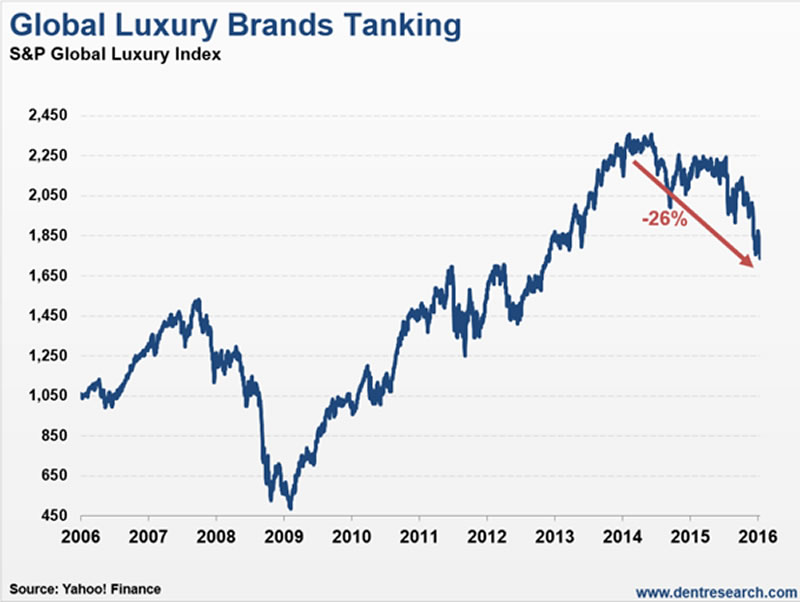U.S. Demographics - The Affluent Market Is Fading FAST
Economics / Demographics Mar 01, 2016 - 04:39 PM GMTBy: Harry_Dent

 About 30 years ago, I was able to predict the U.S. would see a major generational spending peak in 2007, all from my demographic indicator, the Generational Spending Wave.
About 30 years ago, I was able to predict the U.S. would see a major generational spending peak in 2007, all from my demographic indicator, the Generational Spending Wave.
On a 46-year lag from the time they were born, that’s when the peak number of baby boomers would peak in spending for the average household.
After that, they would slow in spending, ultimately sending the economy over a “demographic cliff.” Remember, 70% of the economy relies on consumer spending! When it slows, everything falls with it.
This first demographic cliff happened right on cue, and it helped carry the world into a financial crisis that we’ve still never really recovered from despite unprecedented government stimulus.
But now, there is a second demographic cliff that I’ve been forecasting which appears to be happening in spades, and globally – not just in the U.S. and China.
While the peak number of baby boomers peaked in spending in 2007, the more affluent – the top 10% to 20% – didn’t peak until late last year, 2015. In other words, up until now their spending has still been driving the economy. Going forward, that will be less and less the case.
This group peaked eight years later simply because they tend to go to school longer and have kids later. They peak on about a 54-year lag, not 46 like the peak number of boomers.
Don’t underestimate this group. We’re talking about the spending of the top 10% to 20% during a period of the highest income and wealth inequality since 1928 to 1929. They account for around 50% of income and spending. That gives them much more weight. And that means that as they cut back their spending as they’re already starting to, it’ll carve out a hole in the economy that’ll really kick off this global crash.
Look at the S&P Global Luxury Index, which gives you an indication as to how this group is spending:

This index peaked in mid-2015 and has fallen 26% as of February 11. It’s down much more than the broad S&P 500, down about 15% at worst recently from its high in May 2015.
This is not a coincidence. This is basically an index for affluent spending, and it peaked in the same year this group peaked.
The index includes iconic brands like Nike, Este Lauder, Mercedes, Moet Vuitton, BMW, Carnival Cruises and VF Corporation. But there are many leading brands that have also seen their stocks collapse in recent months or years.
Nordstrom, a brand we all know, is down 36% since last March…
Ralph Lauren has crashed 46% since last January…
Sotheby’s is off 48% since June…
Tiffany & Co. is down 32% since August…
Williams-Sonoma is off 44%, also since August…
And Louis Vuitton, 24% since October...
Clearly, the affluent sector is falling! They have benefited the most from zero interest rate policies and this artificial bubble and “recovery,” but it’s now starting to break down.
This is another monumental change in demographic trends and the final death knell for the economy. If the Fed thought it could fight the demographic decline and debt crisis since 2007 with endless QE and stimulus, I want to see them fight this trend. There’s no way. Game over!
And guess who will lose the most wealth in this next, larger crash? The very group I’m talking about. The top 0.1%, 1%, 10%, and 20%, because they own almost all of the financial assets that have been favored in this bubble period with endless QE and zero interest rates. Worse, it’ll be years before they see another great boom – not until late 2022-forward. And it won’t be like the one we saw from 1983 to 2000.
Now is the time to protect your wealth on this final, desperate rally before stocks see a more serious crash in the year to follow.
Harry
Follow me on Twitter @HarryDentjr
Harry studied economics in college in the ’70s, but found it vague and inconclusive. He became so disillusioned by the state of the profession that he turned his back on it. Instead, he threw himself into the burgeoning New Science of Finance, which married economic research and market research and encompassed identifying and studying demographic trends, business cycles, consumers’ purchasing power and many, many other trends that empowered him to forecast economic and market changes.
Copyright © 2016 Harry Dent- All Rights Reserved Disclaimer: The above is a matter of opinion provided for general information purposes only and is not intended as investment advice. Information and analysis above are derived from sources and utilising methods believed to be reliable, but we cannot accept responsibility for any losses you may incur as a result of this analysis. Individuals should consult with their personal financial advisors.
© 2005-2022 http://www.MarketOracle.co.uk - The Market Oracle is a FREE Daily Financial Markets Analysis & Forecasting online publication.


